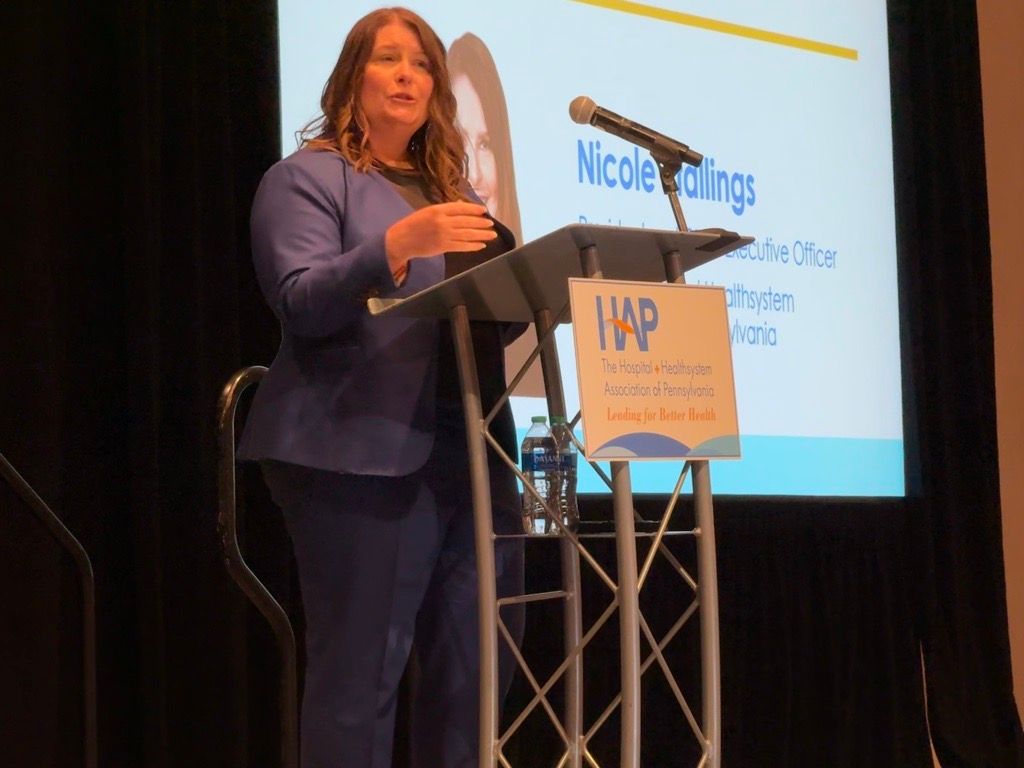Pennsylvania hospital group CEO talks about cyberattack, financial concerns, staffing, and more
Nicole Stallings, CEO of the Hospital + Healthcare Association of Pennsylvania, spoke with Chief Healthcare Executive at the group’s leadership summit.
Harrisburg - More than 200 leaders arrived for the Hospital + Healthcare Association of Pennsylvania Leadership Summit, much to the delight of Nicole Stallings.
Nicole Stallings, president and CEO of the Hospital + Healthcare Association of Pennsylvania, speaks at the group's leadership summit Wednesday.

Stallings became CEO of the organization last summer, so the summit is the first since she took the post. As the summit kicked off Wednesday, she talked with Chief Healthcare Executive® about some key issues facing Pennsylvania hospitals.
The Change Healthcare cyberattack has affected hospitals nationwide, disrupting payments, prescriptions, billing and other functions. Stallings says the impact has affected Pennsylvania hospitals to varying degrees.
Some hospitals work heavily with Change Healthcare, while others have payers or vendors that work with the company, a subsidiary of UnitedHealth Group. Stallings says she spoke to one rural Pennsylvania hospital that is still unable to submit any claims, but hopes to do so by the end of the week.
“Whenever you have this amount of financial uncertainty in terms of cash flow, there are significant concerns regarding the ability to ensure access to care to your patients and to carry out your mission,” Stallings says.
Part of the difficulty for hospitals is that it’s been such a fluid situation. And even as Change Healthcare has made progress in restoring services, Pennsylvania’s hospitals continue to see new impacts.
“It's not over,” Stallings says.
“Every day, every week, hospitals are uncovering different impacts and but at the same time, they're persistent,” she explains. “They're doing what they always do, which is they find a way to deliver care, but they're having to make some really tough choices right now to ensure they can make payroll, that they can pay vendors and that most importantly, they can keep access to care open.”
Even before the cyberattack, Stallings says hospital leaders have recognized the dangers of ransomware attacks to their organizations.
“Hospitals have been for quite some time the number one target of these cybercriminals across the globe and so they've been taking this seriously,” Stallings says.
“I think what this attack, which is unprecedented, has really shone a light on is the vulnerabilities across the healthcare system,” she continues. “And when something like this happens, it's very tied also to the financial stability that our hospitals have. So the hospitals that have the most concerns right now as they continue to navigate this particular attack, often were those with the slimmest margins.”
Finances and staffing
Nearly 40% of Pennsylvania’s hospitals are operating in the red, according to the association’s latest data, while another 13% of the state’s hospitals have operating margins under 4%.
“Those are the hospitals that are being most severely impacted,” Stallings says.
The cyberattack also comes just as some Pennsylvania hospitals, along with hospitals and health systems nationwide, are showing signs of improvement.
Pennsylvania hospitals are also making progress in filling nursing positions and other key positions.
The state’s hospitals reduced turnover for key positions, on average, statewide by 28% from 2022 to 2023, according to the association’s data.
“We are seeing a reduction in some of the reliance on agency staffing, which is certainly very promising,” Stallings says. “We are seeing that our hospitals’ efforts in terms of growing and retaining the workforce are starting to pay off. But our workforce shortages were years in the making, and it's going to take us years to really get to where we need to be to ensure that we can care for Pennsylvanians now and into the future.”
Expanding the workforce
Stallings says the association will be working with Pennsylvania Gov. Josh Shapiro’s administration to develop long-term solutions at expanding the state’s healthcare workforce.
The association is hoping to work with the Shapiro administration to develop more nursing faculty positions, which would enable more people to train for nursing roles.
“We have a lot of interest in joining the ranks of nurses and people that want to care for their communities,” Stalling says. “But unfortunately, the schools of nursing often have to turn qualified students away because they don't have the faculty or the clinical space.”
Stallings also says the association is pushing for more student loan repayment programs that would offer assistance to clinicians willing to work in underserved communities.
“This is a way we think to really grow not just our hospital workforce, but really focused on the rural areas which are even more impacted by workforce shortages,” she says.
Maternal health
The Pennsylvania hospital group is also focused on improving maternal health, which has become a national crisis, healthcare leaders say. The Shapiro administration has demonstrated interest in developing more doulas, who work with women during delivery and throughout pregnancy.
Stallings also highlighted the importance of improving maternal health in rural communities. Nationwide, one in three counties qualifies as maternity care deserts, according to the March of Dimes.
“I think we need to be creative and look at really, how do we make sure that we can incentivize providers to come to rural areas to provide birthing services to individuals,” Stallings says. “And we know if we want to keep or attract businesses into certain areas, you have to be able to deliver children in those communities. That's something that businesses look for.”
“And so we think that any economic development plan, frankly, needs to look at local hospitals, and making sure we have access to services and those areas,” she says.
Newsletter
Get the latest hospital leadership news and strategies with Chief Healthcare Executive, delivering expert insights on policy, innovation, and executive decision-making.